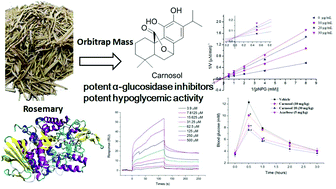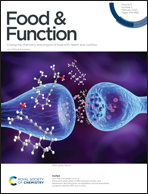Identification of bioactive compounds that contribute to the α-glucosidase inhibitory activity of rosemary†
Abstract
To investigate the bioactive compounds that contribute to the α-glucosidase inhibitory activity of rosemary, phenolics and triterpene acids were characterized and quantified using quadrupole-Orbitrap mass spectrometry and enzyme assay. Two phenolic diterpenes (carnosol and hydroxy p-quinone carnosic acid) and two triterpene acids (betulinic acid and ursolic acid) were identified as potent α-glucosidase inhibitors. Carnosol, a major diterpene in rosemary, showed significant α-glucosidase inhibitory activity with IC50 value of 12 μg mL−1, and its inhibition mode was competitive. The inhibition mechanism of carnosol on α-glucosidase was further investigated by a combination of surface plasmon resonance (SPR) spectroscopy, fluorescence quenching studies and molecular-modeling techniques. The SPR assay suggested that carnosol had a high affinity to α-glucosidase with equilibrium dissociation constant (KD) value of 72.6 M. Fluorescence quenching studies indicated that the binding between carnosol and α-glucosidase was spontaneous and mainly driven by hydrophobic forces. Molecular docking studies revealed that carnosol bound to the active site of α-glucosidase. Furthermore, the oral administration of carnosol at 30 mg kg−1 significantly reduced the postprandial blood glucose levels of normal mice. This is the first report on the α-glucosidase inhibition and hypoglycemic activity of phenolic diterpenes, and these results could facilitate the utilization of rosemary as a dietary supplement for the treatment of diabetes.



 Please wait while we load your content...
Please wait while we load your content...